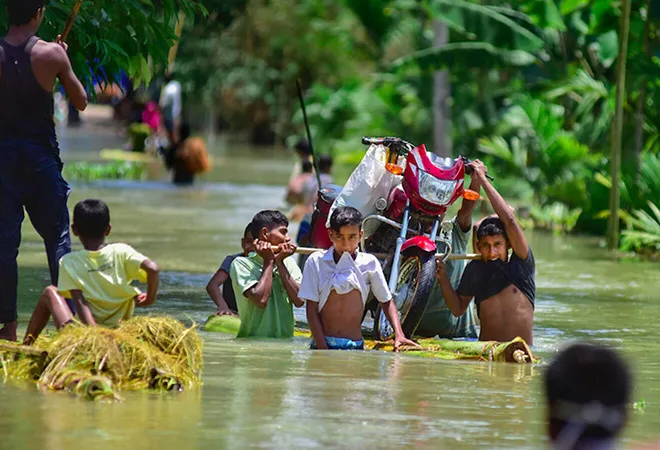
As every year, the month of
June saw a series of dire forecasts of ‘extremely heavy rainfall’ for Assam. And in the month’s third week, the monsoon unleashed its full fury upon the state, with consequences that have now become disturbingly familiar.
Even as the India Meteorological Department issued its
Red Alerts and Orange Alerts, torrential rains raised the water levels of the Brahmaputra and its tributaries, multiple districts were hit by devastating floods, soil erosion began on a massive scale, and emergency relief distribution centres had to be set up. With the dawn of a dark and wet July, Assam’s flood situation was critical. Over
34,000 people found themselves adrift and homeless.
Assam’s climate challenge
The
Climate Vulnerability Index (2021) ranks Assam as India’s most climate-vulnerable state. Several factors are responsible for this extreme vulnerability, chief among which are the presence of the expansive Brahmaputra and Barak river basins, Assam’s fast dwindling green cover, and the overall geoecological fragility of Northeast India. Climate change has
manifested itself in the state most visibly through the growing volatility of annual and seasonal rainfall, as well as a rise in yearly mean temperatures. These two phenomena trigger more frequent extreme precipitation events such as high-intensity rainstorms, which in turn cause Assam’s
three main climate hazards—catastrophic floods, landslides, and soil erosion.
Climate change has manifested itself in the state most visibly through the growing volatility of annual and seasonal rainfall, as well as a rise in yearly mean temperatures.
Nearly
40 percent of Assam’s area is prone to floods; additionally, its monsoons have grown increasingly erratic and unpredictable. Much of the rain expected annually sometimes arrives in a space of weeks. In
2022, for example, Assam received double its average June rainfall in the month’s first three weeks alone.
Torrential concentrated rainfall is also the principal cause of the state’s major landslide events; over 100 lives have been lost to nearly 1,000 landslides in the six-year period between
2016-22. Studies show that landslide frequency is
increasing and could worsen both in Assam and across the Northeast as a whole. Finally, the magnitude of soil erosion that Assam experiences is far greater than that of any other state, with the Brahmaputra’s width increasing significantly in places as a result of
bank erosion, embankments being
breached regularly, with a severe impact on the state’s rural economy because of
shrinking riverine and fertile agricultural lands.
Addressing Assam’s climate and disaster risks
Based on an analysis of Assam’s
State Action Plan on Climate Change 2015-20 (SAPCC) and its
State Disaster Management Plan 2014-22 (SDMP), as well as efforts to implement them, the following measures could be undertaken to strengthen responses to Assam’s climate and disaster risks.
-
Decentralising risk mapping exercises
The process of climate and disaster risk mapping should be made as local as possible. While District Disaster Management authorities have been established to prepare district-level plans and build local capacities across Assam, as a next step, panchayats could be encouraged or incentivised to develop and implement climate action plans (as is being done in
Uttar Pradesh and
Kerala). This would support community-enabled actions, and devolve responsibilities to at-risk communities.
-
Mainstreaming communities into capacity development processes
Assam’s SAPCC and SDMP focus principally on building the capacities of government officials, though training is sometimes also extended to community volunteers and frontline workers. Community training efforts must be approached more systematically, and integrated into action plans more organically, to ensure an effective bottom-up approach to climate action.
Assam’s recent creation of a separate new department on climate change—that will focus on climate threats and measures for adaptation and mitigation—is praiseworthy.
-
Understanding the link between climate change and disasters
SDMPs tend to focus on a list of hazards, but barely elaborate on their connection to climate change. This may have produced an insufficient or incomplete understanding of climate change within the administration (in Assam and elsewhere), and could also reflect a general tendency to focus narrowly on ‘incidents’ rather than their causes or effects. In this context, Assam’s recent creation of a separate
new department on climate change—that will focus on climate threats and measures for adaptation and mitigation—is praiseworthy. It could eventually foreground an understanding of climate risks, help align the agendas and work of various ministries, and facilitate integrated planning.
-
Exploring innovative financing options for climate action and disaster management
Assam’s SAPCC and SDMP do not, at present, include a blueprint for climate or disaster financing from government budgets, but caution that if adaptation efforts are not systematically undertaken and budgeted for, their costs could spiral upwards. Climate adaptation costs must, therefore, be factored into departments’ annual planning processes. In the space of disaster risk reduction, for instance, a
new strategy has recently been approved, under which 3 percent of the annual budget of all departments allied with Assam’s Revenue and Disaster Management department shall be allocated for disaster reduction. More mechanisms of this kind are required.
-
Collaborating with the private sector
Neither the SAPCC nor the SDMP 2014-22 define a strategy for leveraging private sector funds. Assam’s new
Draft SDMP 2022-30, however, marks a departure in this regard and presents several possible private funding options, including the introduction of insurance and risk pooling; provisions for the State government to issue reconstruction bonds in post-disaster scenarios with the Union government’s approval; and crowd-funding as a means of supporting disaster relief and recovery. Each of these options could prove valuable, and ought to be piloted.
The idea of a Northeastern CSR Corpus Fund could be explored, with a view to aggregating the resources of the region’s companies, and then utilising a proportion of the Fund for climate action.
Importantly, the draft SDMP 2022-30 also recommends actively drawing on corporate social responsibility (CSR) funding. Businesses in Assam should be sensitised about how their contributions might benefit climate actions. The idea of a
Northeastern CSR Corpus Fund could be explored, with a view to aggregating the resources of the region’s companies, and then utilising a proportion of the Fund for climate action.
-
Promoting community adaptation initiatives and leveraging traditional knowledge systems
Assam’s SAPCC and SDMP have drawn attention to the importance of ground-up approaches for climate adaptation and disaster management. Ongoing community initiatives such as
tree-planting drives and the creation of water channels to improve drainage must continue. Besides, the adaptation initiatives of indigenous communities—such as the construction of ‘portable’ houses on bamboo stilts by the
Mising tribe of flood-prone eastern Assam—must be showcased, promoted, and replicated.
Light in August?
As a new month advances, there appears to be little respite for the citizens of Assam. As of writing, yet another
‘above normal’ flood alert has been broadcast in Jorhat, the Brahmaputra is expected to rise 10-25 cm in the course of a single day, and the number of people directly affected and displaced by floods so far has risen to
nearly 64,000. Vast swathes of cropland have been destroyed as floodwaters refuse to recede, and large-scale
relief efforts are underway across the state. There is no light at the end of the tunnel for the victims of Assam’s rains in August.
Assam’s SAPCC and SDMP have drawn attention to the importance of ground-up approaches for climate adaptation and disaster management.
Addressing Assam’s climate and disaster risks effectively—and building a lasting change—is likely to be a long and difficult process. As this article argues, it will call for systemic changes at multiple levels: From decentralising risk mapping efforts, involving communities in new ways, and educating administrators and other stakeholders, to crafting and executing progressive climate and disaster management financing options, co-opting the private sector as a partner and ally, and leveraging traditional knowledge systems. Unless urgent action is taken on each of these fronts, the losses to Assam’s lives, lands, and livelihoods will only continue to mount in the years ahead.
Anirban Sarma is a Senior Fellow at Observer Research Foundation
The views expressed above belong to the author(s). ORF research and analyses now available on Telegram! Click here to access our curated content — blogs, longforms and interviews.
 As every year, the month of June saw a series of dire forecasts of ‘extremely heavy rainfall’ for Assam. And in the month’s third week, the monsoon unleashed its full fury upon the state, with consequences that have now become disturbingly familiar.
Even as the India Meteorological Department issued its Red Alerts and Orange Alerts, torrential rains raised the water levels of the Brahmaputra and its tributaries, multiple districts were hit by devastating floods, soil erosion began on a massive scale, and emergency relief distribution centres had to be set up. With the dawn of a dark and wet July, Assam’s flood situation was critical. Over 34,000 people found themselves adrift and homeless.
As every year, the month of June saw a series of dire forecasts of ‘extremely heavy rainfall’ for Assam. And in the month’s third week, the monsoon unleashed its full fury upon the state, with consequences that have now become disturbingly familiar.
Even as the India Meteorological Department issued its Red Alerts and Orange Alerts, torrential rains raised the water levels of the Brahmaputra and its tributaries, multiple districts were hit by devastating floods, soil erosion began on a massive scale, and emergency relief distribution centres had to be set up. With the dawn of a dark and wet July, Assam’s flood situation was critical. Over 34,000 people found themselves adrift and homeless.
